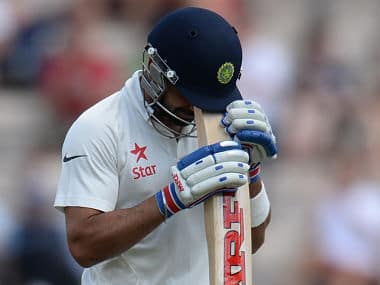By Chetan Narula Virat Kohli has a peculiar habit. Ahead of any match, he tends not to bat in the nets. At the most, he takes throw-downs from the bowling coach or anyone else assigned that duty. It was something pointed out by the batsman himself during the 2014 World T20 in Bangladesh, and the reason given that feeling in good touch and rhythm, he tends ‘not to overdo things’. At that point in time, Kohli was in-form. It is a strange phrase because for the past three seasons, he has blitzed bowling attacks in every part of the world in the shorter formats of the game. Even in the Test arena, he has gone on to score big runs at home as well as in Australia, South Africa and New Zealand. The latter two trips came after a gap since his maiden Test hundred at Adelaide, to the extent that fans and critics even acknowledged his rise by claiming that he had duly filled in Sachin Tendulkar’s number four slot. Then, this England tour came about, as did mighty expectations from every quarter. But the runs have dried up. [caption id=“attachment_1648407” align=“alignleft” width=“380”]  Time for Kohli’s fightback to begin. Reuters[/caption] In three Tests, Kohli has scored 1 and 8 at Nottingham, 25 and 0 at Lord’s, and, 39 and 28 at Southampton. If his scores from the two practice games – 29 at Leicester and 36 at Derbyshire – are considered as well, then, among the top seven Indian batsmen (excluding Rohit Sharma) to have played in all these matches, Kohli is the only yet to score a fifty on tour. By his standards, that is a massive climb-down. And it is clearly more than a mere irritant for the batsman. It could be noticed when he was seen practicing ahead of the Lord’s Test, taking throw-downs against incoming deliveries from a particular length. It could be seen when, one day before the Southampton Test, he arrived at the nets one full hour ahead of the rest of the Indian team. Again, taking throw-downs off that same length! Does this mean that England have found a chink in his armoury? It cannot be said for certain because every batsman is a little circumspect against movement early in his innings. That was the case at Trent Bridge, when Stuart Broad got him early in both innings. At Lord’s, in the second innings, he shouldered arms to a sharp in-swinger from Liam Plunkett, a one-off delivery many would argue. Three innings do not make for enough evidence, or do they? “Kohli is in good nick. He is looking good in those short-stays at the wicket and then he gets out. But it is never as simple as a batsman getting himself out. Partly, he has found ways to get out but at the same time England have bowled really, really well at him,” said former fast bowler Steve Harmison. The worrisome part thus emanates from Kohli’s other dismissals. In the first innings at Lord’s as in the first one at Southampton, he was set up beautifully by Anderson whose out-swingers did enough to get an edge to the keeper. At Lord’s, Kohli had gotten a quick start and then Anderson’s spell lulled him a bit. At Southampton, after another quick get-away, Kohli tightened up, trying to make amends before Anderson returned and got him again. This tactic of shutting-off the run-scoring areas for Kohli bears similarity to the one deployed in the 2012-13 home series against England. Every single time he came out to bat back then, there were fielders at extra-cover, cover and mid-wicket, sometimes in catching positions. The lower bounce on Indian wickets and his tendency to drive the ball made Kohli fall for this trap in the first three Tests, wherein he scored 19, 14*, 19, 7, 6 and 20. “We have bowled to a plan to him, just targeting the top of off-stump and just outside it. We have tried to dot him up and not let him score,” admitted Broad after the third day’s play at the Ageas Bowl. They stifled him back in 2012-13 and England have copied this ploy to a certain extent. It has worked on this off-stump line because of the additional bounce on the pitches here, bringing the cut-shot into contention as much as the drive. As a result, the batsman has been drawn-in forward and back, set up to edge the ball when he presents a straight bat. During his dismissal at Southampton, Kohli’s feet were rooted to the crease, for example. “Kohli has had some good deliveries bowled to him in this series and you need a bit of luck to survive that to capitalize on your starts,” said former England captain Andrew Strauss. “But then at times he has over-done it a bit too. Like the way he got out to Moeen Ali in Southampton. Kohli should have done better.” As the series moves quickly towards its climax, Kohli finds himself in familiar territory. The fourth Test at Nagpur in that 2012-13 series was an important marker in his career, and at that moment in time, he had described it as his ‘most important innings yet’. On a low-bounce pitch, he got a fighting hundred there having learnt where he had gone wrong in the previous three Tests. It was enough to help India get a draw in that match. But the series had been lost earlier. “That series (2012-13) was a learning experience for me and I found out quite a few things I needed to improve upon. The opposition comes out with new ways of getting you out. They want to find out weaknesses in your batting. You have to always be a step ahead. Every game I have looked to improve so I can be a step ahead,” Kohli had said before the first Test. A long, five-match series allows you time to do just that, work out your problems and hit back at the opposition. And the thing about Kohli is that he is too good a player to not tide over his short-comings. The question is, whether he can do it with time to spare, sooner rather than later unlike in 2012-13. With Anderson escaping a ban for his alleged push on Ravindra Jadeja, England do have the momentum heading into the fourth Test at Old Trafford. And India cannot afford to go 2-1 down in the series and then begin to wonder at the Oval, whatever happened to their star batsman?
The thing about Kohli is that he is too good a player to not tide over his short-comings. The question is, whether he can do it with time to spare, sooner rather than later unlike in 2012-13.
Advertisement
End of Article
Written by FP Archives
see more


)

)
)
)
)
)
)
)
)



